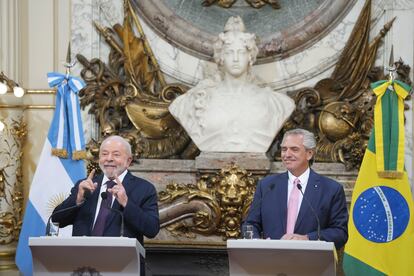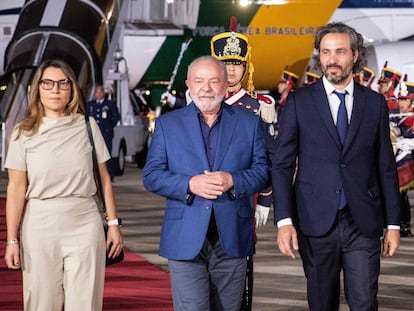Analysts skeptical about possible Brazil-Argentina common currency
Presidents Lula da Silva and Alberto Fernández sign an integration agreement that includes joint energy and financing initiatives

“The weekend joke.” “Crazy.” “I’m surprised it’s being taken seriously.” The social media accounts of economists and market analysts throughout Latin America were full of astonishment this past weekend after The Financial Times reported that the governments of Brazil and Argentina want to create a common currency. They didn’t fully believe it until both governments formally announced it in a joint statement.
“We intend to break down the barriers to our exchanges, simplify and modernize the rules, and encourage the use of local currencies. We decided to advance discussions on a common South American currency that can be used for both financial and commercial flows, reducing operating costs and our external vulnerability,” said the statement, posted on the website of the government of Argentina. The announcement has been met with skepticism, with some experts noting that the chances of creating a common currency for two such different economies are low.
Argentina has been plunged in an inflationary crisis for more than a decade, caused to a large degree by high government spending. Inflation has been exacerbated by the lack of confidence that Argentines have in their own currency, or in other words, in their authorities. President Alberto Fernández told a Brazilian media outlet on Sunday that he would like to eradicate “inflationary logic” and the “fascination with the dollar” that afflicts the South American country.
A new currency that people can believe in again could bring benefits to Argentina, although it is unclear what Brazil could gain from this agreement. While inflation in Argentina approaches 100%, the Central Bank of Brazil is managed autonomously and independently of the government, and it has been one of the most successful in Latin America at containing the rise in global inflation.
“This certainly makes for quite a pretty spicy headline this morning,” Todd Martinez, an analyst at credit ratings agency Fitch Ratings, said on Monday. “I don’t think we have much to say on it yet because I do get the sense that maybe this proposal has been misunderstood. It’s not clear to us that Argentina and Brazil are seeking to adopt a common currency and surrender their current currencies, but perhaps they’re just exploring an option for some new currency or accounting unit through which they conduct bilateral trade.”
Indeed, the common currency that Argentina and Brazil have in mind will not be like the euro that circulates in the European Union, but a currency for commercial and financial transactions that would not replace the Brazilian real or the Argentine peso. It is a project still in its infancy, Brazil’s President Lula da Silva acknowledged on Monday: “We are waiting for our (economic) teams to make a proposal.”
Lula framed the plans for a common currency in both countries’ desire to depend less on the dollar for international transactions. But he also admitted that a similar project by Argentina and Brazil over a decade ago had modest results. “It was a timid experience that did not flow as strongly as we expected,” he said, noting that the initiative consisted of each country authorizing payment in the other’s currency.
Even an initiative with a more restrictive scope is unlikely to bear fruit, analysts at consulting firm Eurasia wrote in a report on Monday. The document highlighted the enormous economic challenges of such a project, especially for Argentina, and underscored that Argentina’s presidential election is scheduled for this coming October, and with the opposition poised to prevail, there is little room for ambitious projects.
“Thinking about the particular case of Brazil and Argentina, we can see that they are very different economies. Both are linked to the export of raw materials, but Argentina has not been able to tighten its belt in decades, while Brazil has a more orderly economy,” said Luis Gonzali, a market strategist at the asset management firm Franklin Templeton.
Relaunching the relationship
The announcement was formally made on Monday in Buenos Aires by Presidents Alberto Fernández of Argentina and Luiz Inácio Lula da Silva of Brazil, who were there to promote the relaunch of the bilateral relationship. The potential creation of a common currency was the most striking aspect of a plan that includes other projects, among which Argentina hopes to include a gas pipeline to export gas to the neighboring country.
“A new history is beginning,” said Lula at a joint news conference where both leaders exchanged embraces and compliments meant to underscore the good relation between both leftist leaders. “I am back to make good agreements with Argentina. To share in the construction of what needs to be built. To help Argentina and Brazil to grow economically.”
Regaining a key international ally also provides a boost to Fernández in a year marked by the October election. Inflation in 2022 reached 95%, the highest in three decades, and the impossibility of tapping international markets for financing makes it difficult to carry out major public works.
One of the most urgent infrastructure projects for Argentina’s government is the Néstor Kirchner gas pipeline. The Fernández administration has already put out to tender the first section, running from Vaca Muerta in the south to the central region. Now it has asked Brazil to finance its extension to the border shared by both countries in order to be able to export the surplus. Argentina ceased to be a gas exporting country years ago, and every winter it is forced to buy liquefied gas from Bolivia. These imports cost up to $1.2 billion a month during the coldest months of the year.
In a 16-page document, the leaders have detailed the ambitious strategic alliance they intend to pursue. It includes the reduction of trade barriers and proposals for energy integration such as the promotion of binational projects and the creation of a South American energy market; and initiatives in scientific, technical, educational and cultural matters.
Sign up for our weekly newsletter to get more English-language news coverage from EL PAÍS USA Edition
Tu suscripción se está usando en otro dispositivo
¿Quieres añadir otro usuario a tu suscripción?
Si continúas leyendo en este dispositivo, no se podrá leer en el otro.
FlechaTu suscripción se está usando en otro dispositivo y solo puedes acceder a EL PAÍS desde un dispositivo a la vez.
Si quieres compartir tu cuenta, cambia tu suscripción a la modalidad Premium, así podrás añadir otro usuario. Cada uno accederá con su propia cuenta de email, lo que os permitirá personalizar vuestra experiencia en EL PAÍS.
¿Tienes una suscripción de empresa? Accede aquí para contratar más cuentas.
En el caso de no saber quién está usando tu cuenta, te recomendamos cambiar tu contraseña aquí.
Si decides continuar compartiendo tu cuenta, este mensaje se mostrará en tu dispositivo y en el de la otra persona que está usando tu cuenta de forma indefinida, afectando a tu experiencia de lectura. Puedes consultar aquí los términos y condiciones de la suscripción digital.
More information
Archived In
Últimas noticias
Most viewed
- Reinhard Genzel, Nobel laureate in physics: ‘One-minute videos will never give you the truth’
- Oona Chaplin: ‘I told James Cameron that I was living in a treehouse and starting a permaculture project with a friend’
- Pablo Escobar’s hippos: A serious environmental problem, 40 years on
- Charles Dubouloz, mountaineering star, retires at 36 with a farewell tour inspired by Walter Bonatti
- Why we lost the habit of sleeping in two segments and how that changed our sense of time










































